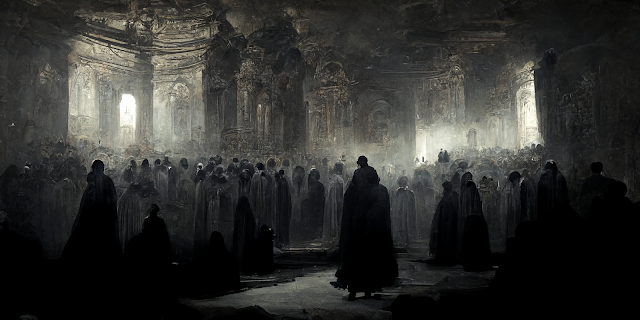 | |||||
| Now you are cursed with knowledge, as I am. She sees you. She looks into your very soul. |
I'm going to deliver the promise of this article right here, right now. NPC motivations matter because...
If you know why someone does something, you know much more about them than just their outward behaviour. You know how they would view the players, how they would interact with the players, you know what their values are, and how to leverage those values to create memorable companions and unforgettable villains.
This article is all about exploring the why.
If you know a character's reasons for doing something, you know how they might change if they get what they want, or if they don't. If you plan on keeping a recurring NPC around for a while, this could be really valuable for you.
Alignment And Epistemology Part 2, The Eight-Year Boogaloo
 |
| If you know, you know. |
To solve this issue, instead of doing years of deep introspection and
psychological work, I can just rely on a framework of personality that
someone else came up with that will help me to explain why other people
do the weird things that they do.
I wrote a bit a long time ago about alignment in D&D and how it wasn't a great system for representing interesting, nuanced characters. (I called that piece part 1, so I guess this is part 2, nearly 8 years later.) Alignment can work, but it doesn't do much for motivation, only for outward personality. Traditional alignment is more about the what than the why of an NPC's actions, and these days I'd argue that knowing the reason is more important. If you want interesting NPCs, knowing why they act is more useful than knowing specifically what they would do in a given scenario. Like, if you ask a Lawful Good character why they did something, they'd probably say 'because it's right' whereas a Chaotic Good character would do something different in the same situation and still claim 'it's right.' There's no difference in why these characters act, only in what they do.
If you want your NPCs to be amusing side-characters whom the players see just for a minute or two and then they're gone forever then that's fine too. You don't need to go into this much depth or detail about a toothless beggar or armless goblin merchant. Caricatures are great in the right places, but knowing and understanding a character's core motivations gives a GM a more interesting route to fleshing out their personalities in the first place, especially if they're going to play a more long-term role in the game.
Not only does knowing a character's core motivation give you ideas about how they'd act, but it also suggests what they wouldn't do, what they might approve of, disapprove of, how they'd go about reaching their goals, and (most importantly) how they'd interact with the players. This can be useful for all kinds of NPCs, from the local village idiot to the gods themselves, including your major antagonists along the way. Plus I really like all that Jungian stuff.
That Jungian Stuff
An idea that's been doing the rounds on YouTube recently is the Enneagram model of personality. Now, I think a lot of this is unreliable and overly prescriptive as a framework for understanding the complexities of real people, but as LocalScriptMan suggests, this kind of pseudoscience can be pretty useful to writers as models for character development and motivation. His main line is that the Enneagram is useful in writing good characters for stories and screenplays, but I think we can say the same for NPCs in a roleplaying game. They're just people, after all. That's the basis of what I'll be talking about from here.
At its very most basic level, the Enneagram functions as a model for telling us about our most basal motivations and fears, and a lot of it is just an extrapolation of those fears. But honestly, that's exactly what we're after. When writing characters, this is a really good thing because it helps us to really maintain a through-line by which we understand them. It keeps them consistent.
Not only that, but the Enneagram suggests quite comprehensively what characters do when they're emotionally healthy, and what they do when their fears get the better of them and they slide into unhealthy patterns of behaviour. You want heroes? Great, use this. You want villains? Great, use this.
The 9 Types
Type 1 Core Desire: Being Good / Being Right
1s want to be right, good, correct,
responsible, appropriate, accurate, virtuous, and ethical. They fear being bad, wrong, unethical, immoral, incorrect, inappropriate, and evil.
Type 2 Core Desire: Being Wanted / Being Loved
2s want to be loved, wanted, needed, appreciated, and seen as kind and helpful people. They fear being unloved, unwanted, not needed, not appreciated, and needy.
Type 3 Core Desire: Being Valuable / Being Admired
3s want to be valuable, successful, admired, respected, and praised. They fear being worthless, a failure,
not valued, not admired, not successful, and inefficient.
Type 4 Core Desire: Being Authentic / To Find Meaning
4s want to be authentic, uniquely
themselves, special, to find their own specific place in this world, to
find meaning. They fear being without significance,
having no identity, being common, being defective, or flawed.
Type 5 Core Desire: Being Competent / Being Capable
5s want to be competent, capable, knowledgeable, self-sufficient, and well-informed. They fear being incompetent, incapable, unknowledgeable, helpless, ignorant, and invaded.
Type 6 Core Desire: Being Secure / Being Supported
6s want to be secure, safe, protected, have guidance, have support, and reliability. They fear being without support,
without guidance, without security, being alone, and being abandoned.
Type 7 Core Desire: Being Satisfied / Being Content
7s want to be satisfied, content, happy, unrestrained, and free. They fear being deprived, trapped in emotional pain, being bored, and limited.
Type 8 Core Desire: Being Independent/ To Protect Themselves
8s want to be self-governed,
independent, and they want to be able to protect themselves (and those
they care about). They fear being controlled, harmed, powerless, weak, vulnerable, and manipulated.
Type 9 Core Desire: Being at Peace / Being Harmonious
9s want to be at peace, harmonious, connected, untroubled, at ease. They fear being separated, being at a
loss with others, conflict, tension, being shut out, and overlooked.
Notice that although most sources tend to give the types their own title to aid in comprehension, I've not done that. This is partly because I don't think the types hold much of use outside their basic motivations, and extrapolating too far from these creates unnecessary stereotypes, as I explain at the end.
Healthy And Unhealthy Behaviours
Each type in the Enneagram has a detailed progression through 9 different states, ranging from most healthy (1-3), to average (4-6), to unhealthy (7-9). Now, I think these get a bit extreme down at the very unhealthy end, with the descriptions start talking about depression, psychosis, mania, all kinds of mental health talking points that I'm not qualified to delve into. On the upper end, there's a certain amount of self-helpy-woo-woo language about the Enneagram, but the general message is pretty solid. In the more middling ranges, we get some really interesting examples of how the types' desires feed into their decisions.
For example, a 5's desire for competence and knowledge might compel them to research a topic deeply before getting involved. This could mean that 5s have a wealth of theoretical skills when they apply themselves to something. However, the same instinct can hold them back if they go too far into it, and no matter how much they find out, they may never feel ready to take that initial plunge for fear of getting something wrong. They hesitate, retreat into their own minds, and withdraw from the world. But it still all comes down to why. The 5 researches because they want to be seen as competent, as being 'good at' something or being 'right.' They hesitate because they don't want people to think they're incompetent or bad. Small conceptual problems balloon into insurmountable obstacles.
On the surface, the 5's motivations seem similar to a 3, but they're not the same. You might think a 3 would want to undertake something for a similar reason (being recognised as the best or receiving praise and accolades isn't so far from people thinking you're skilled or competent), but on the negative side of the spectrum, these desires play out differently. A 5 desires skill and mastery for its own sake, whereas a 3 wants skill to win, to beat other people. While an unhealthy 5 might withdraw and study intensely in order to prepare for something, an unhealthy 3 might attempt to deceive others or even cheat to get what they're after.
After a bit of reading, I think what it comes down to is that, when a type is healthy, they can look beyond the need to acquire the thing they want, and use their acquired methods and skills to benefit themselves and those around them. When a type is average, they're trying their best to acquire what they need, and sometimes their fears get in the way of that, or they fail to see how their actions affect others. And when a type is unhealthy, they pursue their need and insulate themselves against their fears regardless of the impact their actions have on others or themselves; they lash out, they withdraw, they delude themselves, and so on.
Crucially, the types can move between these states when things get better or worse for them, giving your NPCs believable arcs in terms of how they relate to the characters. Do the PCs help out an NPC with something they need? Great, you can make them a more healthy version of themselves. Do the PCs hinder or oppose the NPC in some way? Make them act in a more unhealthy way to simulate their descent into villainy!
I was going to write some examples of NPCs as proof of concept, but I think I'll leave that for another post in the future. This one is already long enough.
Problems
It's not a perfect model. One thing a lot of Enneagram sources do is to apply particular stereotypes over the top of the basic fears and motivations. This is kind of unhelpful because it narrows the envelope for each type and makes them less widely applicable. For example, positioning type 4 as the 'artist' implies that all 4s are artistic, other types aren't, and that all artists are type 4. The same goes for type 5s and the 'scientist' label, or type 8s and being the 'leader.'
In some ways it does seem to fit intuitively that certain types might gravitate towards particular jobs, interests, or roles, but it's not useful when we're trying to distil a character to their most basic function. We're using this to find the 'why' rather than the 'what' of a character's actions. An artist can be motivated to do art by the desire for recognition and fame (being the best, type 3) just as easily as they can by the need for self expression (type 4) or to demonstrate mastery of a particular medium (type 5). Some might even just want to try making art because their friends are into it (type 6) or they're curious and fancy a new hobby (type 7). In my (limited and relatively uninformed) opinion, the Enneagram has nothing to do with whether a person is actually good at something, and everything to do with why they might decide to try it in the first place.
Lastly, this model is great as an emergent way of creating interesting characters, but reverse-engineering it is a little more difficult. For example if you want to create an NPC to do a specific thing or to exist for the players as a particular kind of character (like, I really want this character to get in their way and prevent them from achieving their goal through, like, a meddlesome bureaucracy or something) then you might have a bit more legwork to do in terms of figuring out that character's motivations. It can be done, but it's harder to justify or reconcile everything in reverse.
This has implications for railroading adventures versus letting them unfold naturally as you and your players discover it. Not that railroading is always bad, but retroactively applying this model to a story that exists or that you want to exist is harder than letting the story unfold through the interactions of NPCs with the player characters.
If anyone has used this model in the past to create interesting NPCs, or even their own player characters, write it down in the comments below. I'd be fascinated to hear how this model has helped bring more interesting characters to the table. Or perhaps you disagree completely with my opinions; in which case, come and discuss it!
Peace
p.s. The Lisa Simpson thing was a weird way to introduce the article because she has nothing to do with creating interesting NPCs, but I'm convinced of a Lisa Simpson/Enneagram conspiracy. As a type 1, Lisa attempts to right the world's wrongs and align everything with her idealistic morals whilst maintaining her self-image as an upstanding and righteous person. I'd argue that the Enneagram itself is another type 1's attempt to do the same. Is there a link between the Enneagram and Lisa Simpson's visual design? I doubt we'll ever know for sure, but there could be.
Bibliography
Riso, D.R. and Hudson, R., 1996. Personality types: Using the Enneagram for self-discovery. Houghton Mifflin Harcourt. Link on Google Books.































sidjgbisdgbsdg.png)











